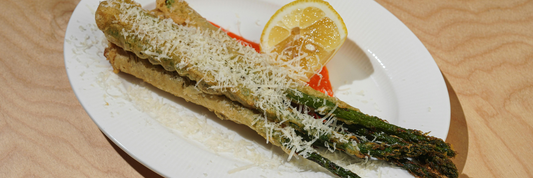In today's eco-conscious world, businesses and consumers alike are turning to more sustainable solutions—and plant-based food packaging is leading the charge. Derived from renewable resources like corn starch, sugarcane, and bamboo, this innovative packaging alternative offers a host of environmental and practical benefits. From reducing our dependence on fossil fuels to cutting down on plastic pollution, the advantages of plant-based food packaging are both impactful and essential for a greener future. In this article, we'll explore why this eco-friendly shift is not just a trend, but a smart, sustainable choice for the food industry.
- What is plant fiber? The reason plant fiber packaging will replace plastic packaging
- Top 5 Food Packaging Trends 2025 for Businesses to Stay Update
- Cellulose Packaging vs. Plastic: Which Is Better for the Environment?
Introduction to Plant-Based Food Packaging

Plant-based food packaging refers to packaging materials derived from renewable biological resources rather than traditional petroleum-based sources. This approach not only aims to meet consumer needs for convenience and safety but also addresses growing concerns about environmental sustainability.
Common materials used in plant-based food packaging include:
- PLA (Polylactic Acid): Made from fermented plant starch, usually corn, PLA is often used for containers, cups, and films. It is known for its clarity and rigidity.
- Bagasse: This is a byproduct of sugarcane processing, often used for plates and containers. Bagasse is sturdy and can resist grease and moisture.
- Mycelium: Derived from mushroom roots, mycelium packaging is biodegradable and has gained attention for its unique ability to grow into custom shapes and sizes.
The trend towards sustainable packaging in the food and beverage (F&B) industry has been accelerating. More brands are seeking alternatives to plastic to reduce their environmental impact, respond to consumer demand for sustainability, and comply with new regulations.
Environmental Benefits
One of the most significant advantages of plant-based food packaging is its potential to reduce environmental harm.
- Reduction in Carbon Emissions: Plant-based materials typically require less energy to produce compared to traditional plastics. According to various studies, switching to plant-based materials can mitigate carbon emissions, contributing to a lower carbon footprint.
- Biodegradability and Compostability: Unlike conventional plastic, many plant-based materials can break down naturally in composting environments. This property greatly diminishes plastic pollution, which has reached alarming levels in oceans and landfills.
- Contribution to Circular Economy: Plant-based packaging often supports a circular economy model. When disposed of properly, these materials can enhance soil health by returning nutrients back to the earth, promoting sustainable agricultural practices.
Functional and Operational Advantages

Beyond environmental factors, plant-based food packaging offers various functional and operational benefits that enhance its appeal.
- Leak Resistance and Insulation: Many plant-based materials boast impressive protective qualities. For instance, PLA offers good moisture barrier properties, while bagasse provides excellent heat resistance, making them suitable for hot food items.
- Flexibility in Design: Plant-based packaging can be designed in various ways to cater to branding needs. This flexibility allows companies to create visually appealing products that stand out on the shelf, captivating environmentally conscious consumers.
- Reduced Food Waste: The superior quality of plant-based packaging helps to preserve food longer, thus minimizing spoilage. Enhanced preservation reduces food waste an important consideration given the global food crisis.
Business and Brand Benefits
Adopting plant-based food packaging can have significant implications for business strategy and brand identity.
- Enhances Brand Image: Companies that use sustainable packaging often resonate well with consumers who value environmental responsibility. This positive image can result in increased customer loyalty and new consumer bases.
- Compliance with Sustainable Packaging Regulations: With an increasing number of governments implementing regulations on packaging waste, transitioning to plant-based options can help businesses remain compliant and mitigate potential fines or restrictions.
- Competitive Advantage: As sustainability becomes a focal point in consumer decisions, businesses that effectively utilize plant-based packaging can differentiate themselves from competitors, tapping into market expansion opportunities.
By positioning themselves as leaders in sustainability, companies can not only meet current consumer demands but also proactively address future market trends.
The advantages of plant-based food packaging extend far beyond environmental concerns; they touch upon functional, operational, and brand-based dimensions as well. As the F&B industry encourages greener practices, embracing plant-based packaging can be an integral step toward a sustainable future. Investing in such innovations is not merely beneficial for businesses; it is vital for the planet we share.
Challenges and Considerations

While plant-based food packaging offers numerous advantages, there are also challenges and considerations that need attention.
Higher Production Costs Compared to Traditional Packaging
One of the most significant obstacles to the widespread adoption of plant-based food packaging is its higher production cost. This price difference can be attributed to several factors, including the cost of raw materials, manufacturing processes, and economies of scale.
Additionally, small and medium-sized enterprises, which may already operate on tight budgets, might find these costs especially burdensome. However, as demand grows and technology advances, it is expected that production costs will decrease, making plant-based packaging more accessible.
Limited Access to Industrial Composting Infrastructure
Another challenge associated with plant-based food packaging is the limited availability of industrial composting facilities. Unlike traditional plastics that can often be disposed of in regular waste, plant-based materials typically require specific composting processes to break down effectively. Unfortunately, many communities lack the necessary infrastructure to support this, leading to confusion about disposal methods and potentially resulting in plant-based packaging ending up in landfills.
To overcome this challenge, local governments and businesses must work collaboratively to develop accessible composting programs, educate consumers, and potentially invest in new technologies for waste management.
Need for Consumer Education on Proper Disposal Methods
Consumer education is crucial for the success of plant-based food packaging. Many people are unaware of how to properly dispose of these materials, which increases the risk of contamination with non-biodegradable waste. Educational campaigns highlighting the benefits of plant-based packaging and providing clear instructions for disposal can help mitigate this issue.
Businesses can play a vital role in this education effort by labeling their products clearly and promoting an environmentally conscious mindset among consumers. By informing individuals about the environmental impact of their choices, they can empower customers to make more sustainable decisions.
Kimecopak.ca – Your Partner in Sustainable Packaging

Kimecopak.ca is dedicated to promoting sustainable packaging options that support both businesses and the environment. With a mission focused on providing eco-friendly solutions, Kimecopak.ca offers a wide variety of plant-based packaging products designed to meet the needs of various sectors.
Introduction to Kimecopak.ca and Its Sustainability Mission
At Kimecopak.ca, the commitment to sustainability goes beyond just selling products. The team believes in creating a positive impact on the environment while supporting businesses in making the switch to eco-friendly alternatives. By focusing on plant-based materials, Kimecopak.ca aims to reduce waste and pollution while promoting a circular economy.
Range of Eco-Packaging Products and Consulting Services
Kimecopak.ca provides a comprehensive range of eco-packaging products suitable for various applications, including food service packaging, retail bags, and shipping materials. In addition, the company offers consulting services to help businesses navigate the complexities of switching to sustainable packaging solutions, ensuring a smooth transition and maximized impact.
Conclusion
Plant-based food packaging presents a promising alternative to traditional materials by offering environmental benefits such as reduced carbon footprint and biodegradable properties. However, it also faces challenges, including higher production costs, infrastructure limitations, and the need for consumer education. By addressing these issues, businesses and consumers can focus on the many advantages and work together toward a more sustainable future.




